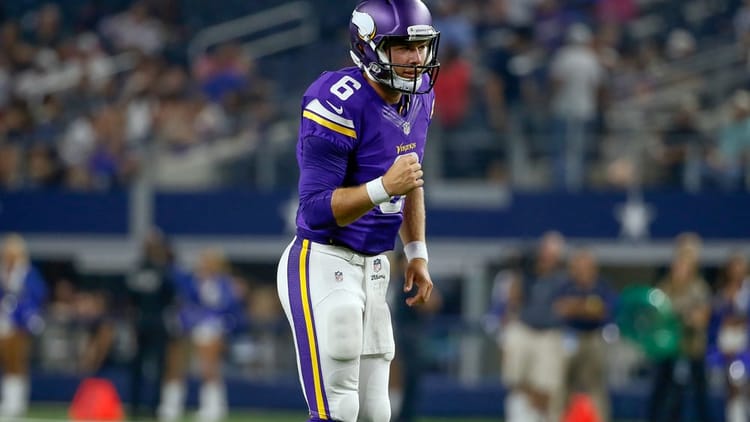Vikings Sign Keenum; Another QB “Controversy” Emerges

In 1978 author Margot Zemach published a children’s book entitled, “It Could Always Be Worse“. Inspired by a Yiddish folktale, the narrative revolves around the philosophical idea that things in life are not always as bad as they initially seem. Zemach’s book was a massive success, as it was named a Caldecott Honor Book and later served as an educational tool for middle school teachers and parents.
Promoting optimism regardless of circumstance is a powerful message, but it is also not necessarily accurate. It is not humanly possible to determine whether or not the Zemach code is universally applicable, but the Minnesota Vikings have spent over 50 years constructing an air-tight case for the existence of worst-case scenarios, situationally (and geographically) disproving the relevancy of this timeless philosophy.
As it pertains to the NFL at least, it’s certainly difficult to imagine a deeper hole than the one Minnesota fell into this past August. At the beginning of June, the Vikings were viewed as darkhorse Super Bowl contender behind quarterback Teddy Bridgewater. The wide-spread expectation — both internally and externally — that the signal-caller would drastically improve during his third season at the helm served the team well in promoting optimism, but it may also have led upper management to ignore the potential impact of Taylor Heinicke suffering an absurd foot injury ahead of preseason play.
Backup quarterbacks serve a strange role in professional football. It is the only NFL role in which an ideal season may be accomplished without recording a single snap. There are multiple ways to fulfill a backup quarterback contract, but every general manager negotiates with the hope that his substitute signal-caller will serve multiple years as an incredibly well-paid clipboard holder — and nothing more.
These players may be almost universally viewed as insignificant, but the fine print in their job description yields a critically important role — limit the damage caused by an NFL worst-case scenario.
Heinicke’s injury this past July subtly set forth an absolutely catastrophic chain of events for the Vikings. Had it not been for the inexplicable story regarding how the second-year Old Dominion product sustained a broken foot, Heinicke being sidelined would likely have gone mostly unnoticed. In combination with Teddy Bridgewater’s knee explosion roughly one month later, however, Minnesota proved it can sometimes be worse while simultaneously putting an exclamation mark on its case for the horrifying existence of the worst-case scenario.
Losing Bridgewater indefinitely was devastating in itself, but the absence of an even remotely threatening replacement left Rick Spielman and the Vikings completely unprepared to handle the situation. Shrugging off Heinicke’s injury coupled with the timing of Bridgewater being lost for (at the very least) the 2016 season proved costly, as the only competitive option available to the Vikings general manager involved surrendering his 2017 first-round pick.
With the nationally-televised reminder of his mistake less than a month away, Spielman opted to trade capital for positional security. As reported by ESPN’s Ben Goessling, the Vikings agreed to a one-year contract worth up to $2 million with former Los Angeles Rams quarterback Case Keenum:
https://twitter.com/GoesslingESPN/status/847918151660711936
Keenum, who has recorded 5,224 passing yards, 24 touchdowns, 20 interceptions and 58.4-percent completion over the course of 26 regular season appearances (24 starts), will join potentially the most intriguing quarterback depth chart in NFL history upon arrival at Winter Park.
The addition of Keenum isn’t exactly a game-changer, but, with a little creativity and optimism, it could be viewed as a rather sizable upgrade. If continuing the legacy of Shaun Hill is his future, the third-string quarterback spot will unequivocally enter the year as the most improved spot on the Vikings 53-man roster.
But, in the event that he was acquired to challenge Heinicke for the No. 2 hole on the team’s endlessly-debated quarterback depth chart, the Vikings will boast their second quarterback controversy of the offseason. In fact, the Heinicke-Keenum debate actually carries more weight than the ongoing Bridgewater-Bradford dogfight.
Minnesota firmly established how important a backup signal-caller can be under the right (wrong) circumstances less than one year ago. Furthermore, Bradford is arguably best-known for his injury history, as the former No. 1 overall pick has torn an ACL twice and missed 18 games throughout his career.
Discussing who the starting quarterback should (hypothetically) be may be the more intriguing debate, but without a single piece of definitive evidence to argue Bridgewater’s claim, The Battle of the Backups genuinely represents the superior quarterback “controversy” in Minnesota.
As for Spielman — who has begun to receive criticism more frequently as of late — ignoring Bradford’s injury history and Heinicke’s lack of regular season experience was simply not an option. Keenum may be the epitome of a backup quarterback, but the Vikings general manager could not afford to lose the preparation battle two years in a row with his current job security.
